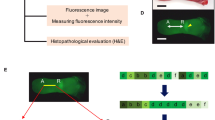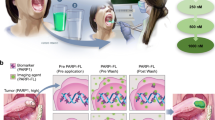Abstract
Early diagnosis improves oral cancer prognosis. Exact demarcation of tumor margins improves surgical outcomes. This study evaluates Photofrin® fluorescence: a new diagnostic procedure for detection of oral neoplasms in animal models. Fourteen male Golden Syrian hamsters were used. 0.5% D.M.B.A (9,10 dimethyl1-1,2-benzanethracene) was brushed onto cheek pouches bilaterally daily for 2,weeks. Hamsters with oral neoplasms received 2.5,mg/ml Photofrin® solution topically. After 3h the neoplasms underwent fluorescence illumination (λex=380–420,nm). A quantitative analysis of the fluorescence contrast between the neoplastic and surrounding tissue was performed using the RGB Mode and the Gray Scale. (GS) Statistical analysis was performed using the ANOVA test. Analysis of the 14 hamsters’ 28 biopsies revealed 4 (14.3%) displayed squamous hyperplasia (1 mild, 3 severe) and 24 (85.7%) displayed squamous cell carcinoma. The sensitivity of neoplasms evaluated using the RGB and GS modes combined resulted in 92.15% (in vivo macroscopic image) and 93.45% (histological). The specificity of neoplasms evaluated via RGB and GS modes combined resulted in 94.78% (in vivo macroscopic image) and 97.30% (histological). The difference between healthy tissue and the lesions as a group is statistically significant. Photofrin® fluorescence provides a sensitive, non-invasive technique for early identification of malignant neoplasms in the oral cavities of animal models.
Similar content being viewed by others
References
R. Baumgertner R.M. Huber H. Schulz et al. (1996) Photochem. Photobiol. 36 169
R.C.J. Benson (1985) J. Urol. 134 675
M.W. Berns J. Coffey A.G. Wile (1984) Laser. Surg. Med. 4 87
C.S. Betz H. Stepp P. Janda et al. (2002) Int. J. Cancer. 97 245 Occurrence Handle10.1002/ijc.1596
C.-J. Cheng C-H. Sun L-H.L. Lian M.W. Bern J.S. Nelson (1999) Lasers Surg. Med. 24 178
M-A. D’Hallewin P.A. Witte ParticleDe E. Waelkens W. Merlecede L. Baert (2000) J. Urol. 164 349
D.X. Divaris J.C. Kennedy R.H. Pottier (1990) Am. J. Pathol. 136 891
T.J. Dougherty G.B. Fiel et al. (1996) J. Clin. Laser Med. Surg. 16 61
R.J. Dunn K.D. Devine (1972) Laryngoscope 82 189
A. Ebihara T.B. Krasieva L.H.L. Liaw et al. (2003) Laser Surg. Med. 32 17 Occurrence Handle10.1002/lsm.10137
K.F.M. Fan C. Hopper P.M. Speight et al. (1996) Cancer 78 1374 Occurrence Handle10.1002/(SICI)1097-0142(19961001)78:7<1374::AID-CNCR2>3.0.CO;2-L
Foote C.S. In: Radicals in Biology, ed. W.A. Pryor. Vol. 2, p. 85. Academic Press, NY, 1976.
D. Frimberger D. Zaak H. Stepp et al. (2001) Urology 58 372 Occurrence Handle10.1016/S0090-4295(01)01222-5
A. Fryen H. Glanz W. Lohmann et al. (1997) Acta Otolaryngol Stockh 117 316
A. Gillenwater R. Jacob R. Ganeshappa et al. (1998) Arch. Otolarygol. 124 1251
C.J. Gomer N. Hayashi A.L. Murphree (1987) on Photochem. Photobiol. 46 843
C.J. Gomer (1991) Photochem. Photobiol. 54 1093
W.K. Hong M.E. Bromer (1983) New Engl. J. Med. 308 75
W.K. Hong W.G. Doos (1985) Otolaryng Clin. N. Am. 18 543
J.C. Kennedy R.H. Pottier D.C. Pross (1990) J. Photoch. Photobiol B. 6 143
J.C. Kennedy R.H. Pottier (1990) J. Photoch. Photobiol. 6 143
D. Kessel (Eds) (1990) Photodynamic Therapy of Neoplastic Disease CRC Pres Inc. Boca Raton FL
K. Koenig H. Meyer H. Schneckenburger A. Ruck (1993) Laser Med. Sci. 127 1993
L. Lipson E.J. Baldes A.M. Olsen (1961) J. Thorac. Cardiov. Sur. 42 623
D.G. Mac Donald (1981) J. Oral. Pathol. Med. 10 186
M.A. Rettenmaier et al. (1983) Prog. Clin. Biol. Res. 170 767
R. Richards-Kortum E. Sevick-Muraca (1996) Annu. Rev. Phys. Chem. 47 555 Occurrence Handle10.1146/annurev.physchem.47.1.555
K. Svanberg T. Anderson D. Killander et al. (1994) Brit. J. Dermatol. 130 743
N. Neen ParticleVan der H.S. Bruijn Particlede R.W.J. Berg et al. (1996) Brit. J. Cancer. 73 925
K.R. Weishaupt C.J. Gomer T.J. Dougherty (1976) Cancer Res. 36 2326
Author information
Authors and Affiliations
Corresponding author
Rights and permissions
About this article
Cite this article
Chang, CJ., Lin, MS., Hwang, PS. et al. Topical Application of Photofrin® for Oral Neoplasms in Animal. Opt Quant Electron 37, 1353–1365 (2005). https://doi.org/10.1007/s11082-005-4215-4
Received:
Accepted:
Published:
Issue Date:
DOI: https://doi.org/10.1007/s11082-005-4215-4




